Crete Travel Guide
Crete is by far the largest of the many Greek Islands and offers something for every kind of traveller through its stunning landscapes, rich history and warm culture. Thousands of years of conquest and habitation have given it a complicated and diverse heritage, which is still apparent in the many breath-taking archaeological sites scattered across the island. Sightseers can investigate the remains of the ancient Minoan culture that flourished here millennia before Christ; generations of Roman, Venetian and Turkish rule have also left their mark and there are fascinating sights throughout the destination.
The northern coastline is home to busy holiday resorts and a wealth of powdery white beaches, where couples and families come to soak up the Mediterranean sunshine. The gateway to the island is the large, modern city of Heraklion, which is not so much an island idyll as a vital commercial centre. Other major holiday resorts in Crete include nearby Malia, lively Agios Nikolaos, Rethymnon with its lovely old town, and Chania to the west, which is known for its 14th-century Venetian harbour and waterfront restaurants.
The wild interior of Crete offers some spectacular mountain scenery drives and many opportunities for hikers and serious cyclists. The White Mountains in the west soar to over 6,561ft (2000m), while the more gentle mountains in the east hide the extraordinary Lasithi plateau in their midst, which is dotted with white windmills. The south coast of Crete is much more remote and rugged than the north. It's crisscrossed with gorges and dotted with unspoilt villages, pretty coves and secluded beaches.
Things to do in Crete
Sightseeing on Crete pulls visitors back through time and into the rich mythology of ancient Greece. Highlights include the Palace of Knossos, the Cave of Zeus, the Monastery of Arkadi, the remains of Gortyna and the Palace complex of Phaistos in the south. The Archaeological Museum and Historical Museum of Crete in Heraklion are also worth visiting. Crete's sun-drenched, sandy beaches are the main attraction, but walkers will adore the island's breath-taking scenery, especially the beautiful gorges and mountains in Chania's Samaria Gorge National Park. In the east, tiny Sitia is worth a peek for its picturesque port; visitors may enjoy stopping in the town for lunch.
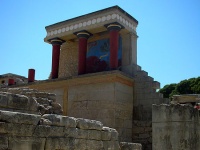
The Palace of Knossos
The Minoan palace at Knossos, covering an area of 215,278 square feet (20,000 sq metres), is one of the world's greatest sightseeing experiences and a must for visitors in the area. It consists of four wings, arranged around a rectangular, central court. The palace originally had many storeys, was built of ashlar blocks, and had walls decorated with splendid frescoes.
British archaeologist, Arthur Evans, who excavated most of the labyrinthine Knossos site, has painstakingly restored some sections of the palace. The remains now visible are actually not those of the original palace, which was built around 2,000 BC and destroyed by an earthquake about 1,700 BC. A subsequent, more complex palace was then constructed and it's these ruins that can still be seen and parts of which have been restored.
The palace was first unearthed in 1878 by a Cretan merchant and antiquarian, but was not systematically excavated until 1900. The Knossos site is about three miles (5km) south of Heraklion.
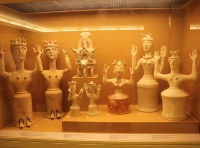
Heraklion Archaeological Museum
A visit to the Minoan palace at Knossos should be complemented with a visit to the wonderful Archaeological Museum in Heraklion. This is one of the largest and most renowned museums in Greece, and even in Europe, and the Minoan collection is the best of its kind in the world. The museum features artefacts spanning 5,500 years of Cretan history and prehistory from the Neolithic (5000 BC) to the Late Roman Period (late 4th century AD). Thousands of artefacts depicting the intriguing Minoan culture are on display, from magnificent bull-headed drinking vessels to the mysterious Phaistos disk inscribed with undeciphered symbols. The exhibition takes up 20 rooms and is arranged chronologically. There's a museum shop where visitors can buy copies, books, postcards and the like, and a museum cafe for refreshments.
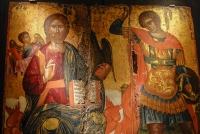
Historical Museum of Crete
This museum deals with Crete's more modern history and highlights the islanders' long battle for independence from early Christian times to the present day. The museum is housed in a two-storey neoclassical building constructed in 1903 on the site of an earlier mansion. The Historical Museum has impressive collections of ceramics, sculptures, coins, jewellery, Byzantine art, Ottoman artefacts, and ethnographic displays, and the history of Crete is thoroughly and well laid out. The medieval and Renaissance collection contains the only painting on Crete by the island's famous painter El Greco, The Landscape of God-trodden Mount Sinai, which is one of the museum's treasures. Another world-renowned Cretan, Nikos Kazantzakis, author of Zorba the Greek, is also remembered in the museum, which houses a recreation of his study. There are frequent temporary exhibitions to be enjoyed, and there's a library containing some interesting documents and rare editions.
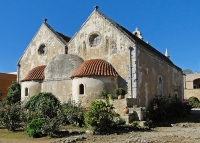
Monastery of Arkadhi
Situated about 14 miles (23km) south of Rethymnon, the Monastery of Arkadhi is something of a national Cretan shrine. During the 1866 rebellion against the Turks the monastery became a refuge for Cretan insurgents and their families (it was the Cretan Christians who revolted against Turkish rule in the rebellion). They were surrounded by the Turks and after two days of fighting, ignited the gunpowder storeroom, which killed hundreds of both Turks and Cretans.
The tragedy brought international recognition to the cause for Cretan independence and those who died in the blast have become celebrated martyr figures. An ossuary displays the skulls of many of the victims and it's possible to see the roofless room where the explosion took place, as well as the surviving 16th-century church that's one of the loveliest Venetian buildings on the island.
There's also a small museum that details the history of the monastery and the battle for independence. It's a very interesting and rather sad place to explore and gives visitors some valuable insight into Cretan nationalism and history.
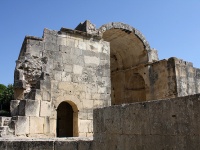
Gortyna
Gortyna is both a municipality in Greece and an archaeological site on Crete that was once the Roman capital of the island. The two are unrelated. The remains of the ancient city of Gortyna, to the south of Heraklion, tell a later tale than that of the other archaeological sites in Crete, despite the fact that there's evidence of human settlement in the area dating back to the Neolithic era.
The greatest treasure of the site is the Gortyn Law Code, recorded on important inscribed stones that date back to the 5th century BC. These remarkable stones are a complete code of law based on Minoan tradition. The Code stones are still preserved and exhibited in the north round wall of the Roman Odeon at the Gortyna site (although of course the theatre was built much later, in the 1st century).
Other highlights at Gortyna include the Church of St Titus, where Christianity was first introduced to the island, and the Temple of Apollo Pythios, which dates from 700 BC. The city was thriving before Roman invasion but its early alliance with the Romans meant that it wasn't invaded and became even more powerful in the region. The site is often called Gortyn, rather than Gortyna.
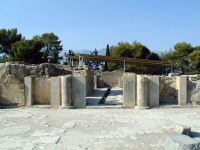
Phaistos
South of Heraklion lies Crete's second most important Minoan archaeological site, the Palace complex of Phaistos, considered by many to be a finer example of Minoan architecture than Knossos. The west propylon, the monumental entranceway to the palace, is particularly impressive, and the ceremonial staircase and great court are breathtaking.
Like Knossos the site has actually been built on twice, with the original palace, built about 2000 BC, having been destroyed by fire and replaced with a new palace around 300 years later. A number of valuable artefacts have been found on the site including the Phaistos disc, which was discovered in 1908 in the basements of the northern complex of the palace. This artefact is a clay disk, dated to between 1950 BC and 1400 BC and impressed with a unique and sophisticated hieroglyphic script.
A number of tombs were also found a short distance from the ruins of the palace complex, and these are thought to belong to the one-time rulers of Phaistos. The city of Phaistos is associated with the mythical king of Crete, Rhadamanthys, and the city is mentioned in many old texts including Homer, who detailed the city's involvement in the siege of Troy. For anyone with an interest in archaeology, Phaistos is a must.
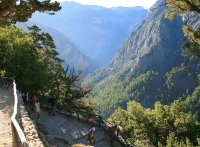
The Samaria Gorge
The Samaria Gorge National Park, in the White Mountains of western Crete, is said to be one of the most splendid scenic parks in Europe and the hike through the gorge is breathtaking. It's an arduous trip but well worth it to see one of the great natural wonders of Europe.
From the top of the gorge it's a 10 mile (16km) hike through the dramatic geological formations and wildflower-strewn cliff sides of the National Park. There are lots of awe-inspiring views and natural features along the way and it's a dream for photographers. Once inside the gorge hikers tend to follow the water, which helps keep them cool, but they must note that they will be in direct sun at least part of the time, so it's important to come prepared with hats, sunscreen and water.
Hikers are always delighted to see that there are restaurants and bars at the end of the walk to provide well-earned refreshment. From the village of Agia Roumeli at the end of the gorge hikers board boats to sail to Khora Sfakion or Paleohora where there are buses back to Haniá, Rethymnon or Heraklion. Nature-lovers will find the gorge one of the absolute highlights of a visit to Crete.
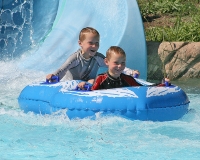
Lido Waterpark
Lido Waterpark offers wonderful games, activities, sun, fun and more, and is a must for families on holiday in Kos, especially those with young children. It's one of the largest waterparks in Greece and features numerous slides, pools, jacuzzis, hydromassage facilities and tubing courses. Those who prefer land activities can enjoy sunbathing, beach volleyball and even trampolines, and there's a special area for young kids too little to try the slides. Visitors will also find a bar and multiple restaurants for food, drinks and snacks, and even a mini-market for shopping. The park is clean and safe, with the water recycled and renewed on a daily basis and a team of qualified lifeguards permanently on duty. Visitors should remember to pack sunscreen, as the summer heat and all the water can mean serious sun exposure.
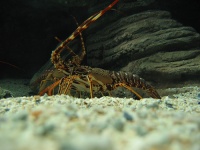
Aquaworld Aquarium
Aquaworld Aquarium is a captivating destination showcasing diverse marine life. Established to educate visitors about local ecosystems, it features a range of exhibits, including colourful tropical fish, reptiles and even rescued sea turtles. The aquarium emphasises conservation, offering interactive experiences such as animal feeding and touch pools, where guests can engage with sea creatures safely. Aquaworld also promotes awareness of environmental issues affecting marine habitats. Ideal for families and marine enthusiasts alike, it provides an enriching experience while highlighting the importance of preserving our oceans. A visit promises both fun and valuable insights into aquatic life.
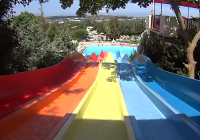
Limnoupolis Waterpark
A fantastic place to take the kids during the heat of summer while on holiday in Crete, the Limnoupolis Waterpark offers fantastic rides, slides and water fun. Limnoupolis is located in a green, scenic area that sets it apart from many other parks of its kind, which are often sadly devoid of vegetation.
There should be something for everyone at this park: for thrill seekers, slides such as Black Hole should summon up some adrenalin; for more mellow fun there are multiple water slides such as the Crazy River, the Giant Slide, and the Triple Twist; for those who merely want to relax and unwind there's the the jacuzzi area; for kids there's a special pool and play area.
In the unlikely event that children get bored there are also video games to play. Visitors will find a nicely designed pool bar and rope suspension bridge over the main pool as well as an artificial island in the middle. There are restaurants and a mini-market for refreshments. Lifeguards are permanently on duty to ensure that visitors stay safe.
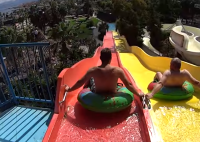
Star Beach Water Park
Star Beach Water Park features all the expected things, such as various nice pools and four big water slides ranging from the relaxing to the thrilling, but it also offers traditional beach watersports such as jet skiing, scuba diving, waterskiing and banana boat rides, and a kind of bungee jumping, to name a few. There are sun beds and umbrellas in relaxation areas by the pools and tubing rivers for lazy sun worshippers and parents to float along while the kids let off some steam. There is also a spa that offers various beauty treatments. For the really little kids there is Baby Star Beach, a children's water playground with shallow pools. Star Beach has an amazing variety of amenities and activities including free WiFi and free foam parties on a daily basis. There are lifeguards permanently on duty so the park is very safe. Needless to say there are also restaurants and a bar to replenish energy for more fun activities. This is a great trip for the whole family and a good combination of wholesome beach fun and poolside relaxation.
Things to do with kids in Crete
Crete's miles of coastline can delight kids on holiday, though they're far from the only child-friendly attraction on the island. The pirate-ship cruise from Rethymno is usually a favourite, and kids also enjoy Chania's Limnoupolis Water Park, or jet skiing and snorkelling at Star Beach Water Park in Hersonissos. A day-trip north to the small island of Spinalonga is another fun option, where families can explore the former leper colony's fortress. Kids tend to find the place spooky and fascinating, as the streets and buildings are abandoned. Travellers should tell kids the Minotaur story when visiting Knossos Palace, as the legendary creature is said to have lived there. Kids can let their imaginations run wild within the ruins, as well as at other ancient, atmospheric places.

Lido Waterpark
Lido Waterpark offers wonderful games, activities, sun, fun and more, and is a must for families on holiday in Kos, especially those with young children. It's one of the largest waterparks in Greece and features numerous slides, pools, jacuzzis, hydromassage facilities and tubing courses. Those who prefer land activities can enjoy sunbathing, beach volleyball and even trampolines, and there's a special area for young kids too little to try the slides. Visitors will also find a bar and multiple restaurants for food, drinks and snacks, and even a mini-market for shopping. The park is clean and safe, with the water recycled and renewed on a daily basis and a team of qualified lifeguards permanently on duty. Visitors should remember to pack sunscreen, as the summer heat and all the water can mean serious sun exposure.

Aquaworld Aquarium
Aquaworld Aquarium is a captivating destination showcasing diverse marine life. Established to educate visitors about local ecosystems, it features a range of exhibits, including colourful tropical fish, reptiles and even rescued sea turtles. The aquarium emphasises conservation, offering interactive experiences such as animal feeding and touch pools, where guests can engage with sea creatures safely. Aquaworld also promotes awareness of environmental issues affecting marine habitats. Ideal for families and marine enthusiasts alike, it provides an enriching experience while highlighting the importance of preserving our oceans. A visit promises both fun and valuable insights into aquatic life.

Limnoupolis Waterpark
A fantastic place to take the kids during the heat of summer while on holiday in Crete, the Limnoupolis Waterpark offers fantastic rides, slides and water fun. Limnoupolis is located in a green, scenic area that sets it apart from many other parks of its kind, which are often sadly devoid of vegetation.
There should be something for everyone at this park: for thrill seekers, slides such as Black Hole should summon up some adrenalin; for more mellow fun there are multiple water slides such as the Crazy River, the Giant Slide, and the Triple Twist; for those who merely want to relax and unwind there's the the jacuzzi area; for kids there's a special pool and play area.
In the unlikely event that children get bored there are also video games to play. Visitors will find a nicely designed pool bar and rope suspension bridge over the main pool as well as an artificial island in the middle. There are restaurants and a mini-market for refreshments. Lifeguards are permanently on duty to ensure that visitors stay safe.
Eating Out
Cretan food relies on fresh, healthy ingredients. The region's cheeses include Graviera, Myzitra, or Anthotiros cheeses; other traditional dishes include snails, Cretan pilaf (chicken and lamb risotto served with goat's butter), and a chicken soup with lemon sauce called kotosoupa. Dinner is a late affair, as locals usually eat at 10 or 11pm. Resorts and hotels have international restaurants, though they tend to be more expensive and of lesser quality than local tavernas. It's customary to dine 'family style', meaning everyone's welcome to each dish.
Nightlife
Crete isn't as well-known for its nightlife as some other Ionian Islands, but it has its fair share of appeal, particularly within the busy resort towns of Heraklion and Limenas Hersonissos. Bars, clubs, discos, lounges and pubs abound in Heraklion Town, Iraklio, Hania, Rethymno and Agios Nikloas.
Malia, Chania and Hersonissos are hot spots for package holiday tourists, though bars and clubs cater to a younger crowd intent on a lively night out. Older travellers will enjoy Chania's fantastic restaurants, pubs, lounges and tavernas, and they can join locals for their volta: a leisurely stroll or a horse-drawn carriage ride before sundowners or dinner.
Getting Around
A comprehensive bus system makes Crete easy to navigate. Frequent bus services work the north coast, while less frequent services cater to the south coast via the mountainous interior. Crete's towns and resorts also have many tour companies that offer excursions to all major sites. Ferries link the towns along the south coast and the islands, but many only operate during summer. Taxis can take visitors to all sites and are reasonably priced, especially if two or three passengers share. Travel agents can find English-speaking drivers to act as guides. For visitors with limited time on the island, hiring a car is the most flexible way to travel outside the cities and towns. Renting a car allows visitors to leave the overdeveloped tourist trail and explore the real Crete.
Crete Climate and Weather
Crete has a largely Mediterranean climate, with some influences from North Africa's weather patterns. Visitors will find hot, dry summers and mild winters. Peak summer temperatures generally range from 86ºF (30ºC) during the day to 72ºF (22ºC) at night, though it can get significantly hotter during heat waves. Rainfall is almost non-existent in summer but showers can be expected between October and April. Crete's mountains sometimes receive snowfall during winter. Otherwise, snow is rare on the island. Some find Crete uncomfortably hot and humid during mid-summer, so spring and autumn may be the best times to visit for walking and sightseeing, when travellers can expect milder weather and smaller crowds.
Greece travel info
Electricity
Electrical current is 230 volts and 50Hz. A variety of plugs are in use, including the European-style two-pin and the round three-pin.
Language
Greek is the national language, but English is widely spoken.
Money
The official currency is the euro (EUR), which is divided into 100 cents. All major credit cards are accepted and ATMs are widespread; mobile payment systems such as Google Pay and Apple Pay are supported.
Tipping
A service charge is automatically added to most restaurant bills and an additional tip is not expected, though it's always welcome. Rounding up the bill is sufficient for drinks at cafes; taxis, porters and cloakroom attendants will expect a tip.
Health
Most health problems come from too much sun and too much food or alcohol, though there's also the risk of encountering sea urchins, jellyfish and mosquitoes. Medical facilities in major cities are excellent but some of the smaller islands are a long way from a decent hospital. Larger towns and resorts have English-speaking private doctors and the highly professional local pharmacies can usually deal with any minor complaint. Travellers should take along any necessary prescription medication in the original container, which should have a prescription label. The name on the prescription must match the name on the traveller's passport. Food and water are safe, but those visiting for short periods should consider sticking to bottled water. After Brexit, the Global Health Insurance Card (GHIC) replaced the European Health Insurance Card (EHIC) for UK citizens. The GHIC allows UK citizens access to state healthcare during visits to the EU. The GHIC is not valid in Norway, Iceland, Liechtenstein or Switzerland, nor is it an alternative to travel insurance.
Safety
Though Greece is a safe destination, peak tourist season usually sees a spike in petty theft cases, especially in crowded areas. Visitors should conceal valuables or store them in hotel safes and watch out for pickpockets. Violent crime is rare but there have been incidents on some islands; visitors travelling alone should not accept lifts from strangers.
Demonstrations take place regularly, particularly in Athens around Syntagma Square, Omonia Square and Exarchia, and Thessaloniki around Aristotelous Square, Egnatia Street, the Arch of Galerius and the campus of Aristotle University. These protests draw large groups of people and often take place with little notice. They can disrupt public transport and roads; protesters and police might also clash. Sometimes petrol bombs and fireworks are thrown by protesters, and police deploy tear gas. Protests are usually held on days of social or historical significance, such as Workers' Day on 1 May, the commemoration of the Athens Polytechnic uprising of 1973 on 17 November, and the commemoration of the riots of 2008 on 6 December. Violent clashes can occur between supporters of rival football teams during which Molotov cocktails and stones have been thrown, and people have been killed. Travellers should avoid areas where demonstrations and large gatherings are taking place, follow the instructions of local authorities, and monitor local media for information on ongoing demonstrations. Transport and tour operators don't always follow safety and maintenance standards. Travellers should always check if their travel insurance policy covers the pursuit in question, ask about and insist on minimum safety requirements, and always use available safety gear, such as life jackets or seatbelts. If proper safety equipment isn't available, they should use another provider. There's a high risk of wildfires during the summer season from April to October, and visitors should be cautious if they're in or near an area affected by wildfires. If travellers find themselves in these sorts of situations, they should follow the guidance of the emergency services, or call the Greek emergency services on 112 if they're in immediate danger.
Local customs
Most Greeks are more traditional than the British in some ways, but they're also friendly and welcoming enough to seem intrusive to reserved British tourists. Greeks are the heaviest smokers in Europe and will often ignore the smoking ban in public places. Swimwear is expected on the beach but tourists should dress properly in bars and restaurants.
Doing business
Greeks prefer to dress formally in dark-coloured suits for men and stylish outfits for women. Punctuality is important to them, though meetings may not start immediately. Visitors should offer a firm handshake and maintain eye contact when greeting Greek men and women for the first time, and print business cards in both Greek and English. There's no ritual surrounding the exchange of business cards.
As Greeks like getting to know their colleagues before conducting any serious business, it's unlikely a deal will take shape at the first meeting. The local culture follows a hierarchical structure and visitors should show respect in the same way. Gift giving is common in social settings but not necessarily in business.
Duty free
Travellers visiting from inside the EU can bring in 800 cigarettes, or 200 cigars, or 400 cigarillos, or 1kg of tobacco, 10 litres of spirits with an alcohol volume over 22 percent, 20 litres of spirits with an alcohol volume under 22 percent, 90 litres of wine and 110 litres of beer.
Visitors arriving from outside the EU and are over the age of 17 will not pay duty for 200 cigarettes, or 50 cigars, or 100 cigarillos, or 250g of tobacco, 1 litres of spirits with an alcohol volume over 22 percent, 2 litres of spirits with an alcohol volume under 22 percent, 4 litres of wine and 16 litres of beer.
Communications
The international access code for Greece is +30 and the outgoing code is 00, followed by the relevant country code (e.g. 0044 for the United Kingdom). Free WiFi is available at cafes, hotels, restaurants and similar establishments throughout Greece; travellers can purchase local prepaid SIM cards for unlocked phones or use eSIMs if their cellular providers support it on their networks.
Passport & Visa
The borderless region known as the Schengen Area includes the following countries: Austria, Belgium, Czech Republic, Denmark, Estonia, Finland, France, Germany, Greece, Hungary, Iceland, Italy, Latvia, Lithuania, Luxembourg, Malta, The Netherlands, Norway, Poland, Portugal, Slovakia, Slovenia, Spain, Sweden, and Switzerland. All of these countries issue a standard Schengen visa that has a multiple entry option, and which allows the holder to travel freely within the borders of all the aforementioned countries.
Non-EEA travellers to Greece must hold visible means of financial support to cover their stay in the country. It's also recommended that non-EEA members hold return or onward tickets, and the necessary travel documentation for their next destination. Passengers not holding onward tickets may be asked for proof of sufficient funds for their return or onward journey. It's highly recommended that travellers' passports have at least six months' validity remaining after the intended date of departure from their travel destination. Immigration officials often apply different rules to those stated by travel agents and official sources.
Entry requirements
US citizens must have a passport that is valid for six months beyond the period of intended stay. No visa is required for a touristic stay of up to 90 days within a 180 day period.
UK citizens must have a passport that is valid for six months beyond the period of intended stay. No visa is required for a touristic stay of up to 90 days within a 180 day period.
Canadian citizens must have a passport that is valid for at least three months beyond the period of intended stay in Greece. No visa is required for a touristic stay of up to 90 days within a 180 day period.
Australian citizens must have a passport that is valid for at least six months beyond the period of intended stay in Greece. No visa is required for a touristic stay of up to 90 days within a 180 day period.
South African citizens must have a passport that is valid for at least three months beyond the period of intended stay, and a valid Schengen visa, to enter Greece.
Irish citizens must have a passport that is valid on arrival in Greece. No visa is required.
New Zealand citizens must have a passport that is valid for at least three months beyond the period of intended stay in Greece. No visa is required for a touristic stay of up to 90 days within a 180 day period.
Useful contacts
Greek National Tourism Organisation, Athens: www.visitgreece.gr
112 (general European emergency number); 171 (tourist police)


